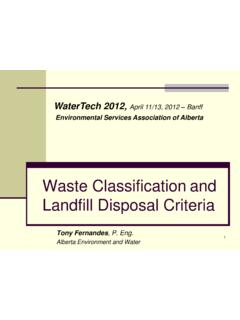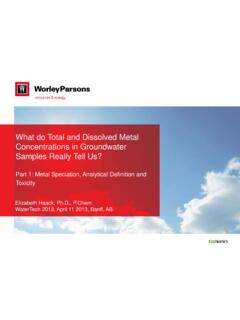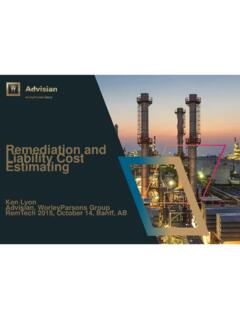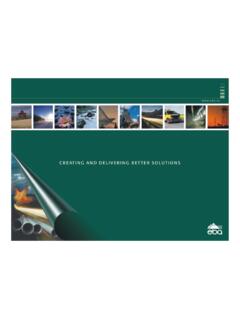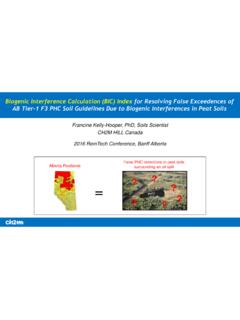Transcription of Peracetic acid A new solution for wastewater …
1 WaterTech2015 Peraceticacid A new solution forwastewater disinfectionPrepared by: Jean Par , P. Acid as wastewater OverviewWhat is PeraceticAcidThe Peracetic acid molecule is simply an acetic acid (vinegar) molecule with an extraoxygen such that there is an O-O acid is an equilibrium mixture of Peracetic acid, hydrogen peroxide, water and acetic acidCH3 COH + H2O2CH3 COOH + H2 OAcetic Acid Hydrogen Peracetic Acid Water PeroxideO O The PeroxychemVigorOxWWT II is a 15% PAA / 23% H2O2formulation which is formulated for maximum efficacy with maximum II compositionComposition by weight percentPeraceticAcid, 15 %Hydrogen Peroxide, 23 %Acetic Acid, 16 %Water (free)
2 , 45 %Stabilizer, <1 %Other PAA don t contain up to 23 % Hydrogen Peroxide = less activeVigorOx WWT II propertiesWill maintain for a long period and saves time by eliminating the need for repeated assay testingPropertiesPhysical stateLiquidOdorpungent vinegar smellDensity g/mL Freezing point-56 FpH< 1 as is ( for a 1 % solution )Solubilitycompletely solubleStabilityone year at temperatures below 84 Ffour months below 100 FNFPA Flammability:flashpoint above 200 F Health: short exposure cause injury Reactivity: violent decomposition at high T Oxidizer123OX30 Years of PAA Microbial Control 1980199020002010 Medical Device SterilizationSurface SanitizationVigorOx LS&DVigorOx Citrus XACitrus Canker ControlPoultry ProcessingSpectrum PAA 35 VigorOx WWT IIWastewater DisinfectionVigorOx O&GOil Field BiocidePMRA Canadian Approval For disinfection of Sewage and wastewater Effluents in Treatment (since May 2014)PlantsUse VigorOx WWT II to treat sewage and wastewater effluent related to public and industrial wastewater treatment plants.
3 VigorOx WWT II may be applied directly to the effluent or may be used with UV light. Add VigorOx WWT II to effluent water at a concentration of ppmto 4 ppmperoxyaceticacid. The maximum amount of peraceticacid that can be discharged is:i. * DF, where DF 12 andDF = plant effluent discharge + receiving stream 7Q10plant effluent discharge receiving stream; orii. 1 ppmif the 7Q10 is unknown or DF < 12. MEDDLCC has granted their authorization for its use in QuebecNote: 7Q10 is the minimum average 7-day flow expected to occur once every 10 years for the receiving streamSafetyMain HazardExothermic Decomposition Over pressurization of tanks/lines Increase of T (evaporation of water and then acetic acid) Trigger: contamination (+2 metals such as iron, copper, nickel).
4 Safety Stanards Materials Pressure relief Containment Dilution123 OXClassificationDOT Class Organic PeroxideNFPA 30 Class III A combustible liquid, cannot sustain a flameNFPA 400 Class IV Organic PeroxideNFPA 704 SafetySafety risk profile is much lower than chlorine gas PAA is a liquid, leaks/spills are easily contained Spills easily handled dilution and decomposition to water/acetic Appropriate design of storage and handling equipment Appropriate use of PPEA dvancements in PAA wastewater disinfection Peracetic Acid Background Why Consider VigorOx WWT II Peracetic Acid Data Sources Drivers for Conversion disinfection Efficacy Process Implementation Conversion Path & Regulatory InvolvementDrivers for use of PAAC hlorine ToxicityNeed to add dechlorinationHigh Operating CostChlorine SafetyChlorine DBPsDisinfection CapacityNeed
5 To replace chlorination with UVNeed to upgrade system or increase capacityHigh Capital CostPAA can be the most economical disinfection alternative New contact channelNew UV systemNew chlorination systemVigorOx WWT II experience Twenty VigorOx WWT II wastewater disinfectionapplications over the last two of VigorOx in wastewater have covered a wide range of waters and climates5 MGD3yrFull Scale 92 / 240 MGD6 month Full Scale 8/25 MGD1 yrFull Scale 15/45 MGD5 yrFull Scale EfficacyEffective DoseIndicator OrganismBacteriaE-ColiFecal ColiformVirusPoliovirusAdenovirusDemandT SSCODBODA mmonia **Contact TimeContact TankFlow rangesPAA s cost effectiveness depends on the effective dose (site-specific)Efficacy Indicator OrganismMatrixOrganismInactivation (log)Dose (mg/L)Time (minutes)ReferenceSecondary effluent Total al.
6 , 2007 Secondary effluent Total coliform2216 Stampiet al. 2002 Secondary effluent Total coliform3227 Koivunenetal,.2005 Secondary effluentTotal coliform4 al., 2001 Secondary effluentTotal coliform4315 Madoniet al., 1998 Secondary effluent Fecal coliform3216 Stampiet al. 2002 Secondary effluentE. al., 2007 Secondary effluent E. coli3216 Stampiet al. 2002 Secondary effluentE. al., 2001 Secondary effluentE. coli3410 Dell Erbaet al., 2004 Secondary effluentEnterococci4315 Madoniet al., 1998 Secondary effluent Enterococci2216 Stampiet al. 2002 Secondary al.
7 , 2001 PAA s efficacy against bacteria has been well documentedEfficacy Indicator Organism0123456781 10 100 1,000 10,000 100,000 Bacteria, WWMS2 phage, WWVirus, DMWP ublished PAA efficacy data demonstrate wide range of actionCt (mg/L*min)Log Reduction0123456781 10 100 1,000 10,000 100,000 Efficacy Indicator OrganismVigorOx proven effective against bacteria and viruses in WWCt (mg/L*min)Log Reduction Bacteria, WW (VigorOx) Virus, WW (VigorOx)ON1ON1ON1ON1ON1TN1CA1MI1CA3TN2T X2FL1WA1MN1IL1TX1FL2MO1 Efficacy Demand (TN2)02468101201020304050 PAA Residual (mg/L)Contact Time (minute)4 mg/L7 mg/L10 mg/LDPAA= f (TSS, TOC, BOD, etc, etc)The effluent s PAA demand is driven by multiple quality parameters Efficacy Demand (TN1)02468101214160500100015002000250030 00 VigorOx demand (mg/L)Color (PtCo)Max PAA demand: 14 ppmMax Chlorine demand: 40 ppmIn some high-demand sites, Color correlated better than TSS or BODE fficacy Contact Time (TX1)VigorOx proved effective at contact times shorter than chlorineVigorOx: ppm@ minChlor/Dechlor.
8 Ppm@ 15 minEfficacy UV Synergies (NY1)Comparison between: Log inactivation achieved with UV only (blue) Log inactivation achieved with 50% of the UV dose plus 1 ppm VigorOx at 30min contact time (red)A 50% reduction in required UV dose (potentially a 50% reduction in power consumption) was observed. VigorOx showed synergistic effect with UV, potentially reducing costand its impact on the environmentCorMix Study with MWH PAA concentration gradient post outflow point Coupled with aquatic toxicity data, can show impact of VigorOx WWT on environment Residual decomposes quickly intoenvironmentally benign compounds: water and vinegarConclusionsRecent field applications of VigorOx WWT II (15% PAA) in municipal wastewater disinfection demonstrate that PAA.
9 Can achieve equivalent chlorine performance at lower doses Typically requires shorter contact times than chlorine (TX1, WA1) Will not generate TTHMs, Cyanide or NDMA (FL1, IL1, CA1) Is less toxic than chlorine and may not require quenching (FL1, ON1, TX1) Can be implemented with on-line residual monitoring and control (NY2) Can be as effective as chlorine against viruses (ON1) Can meet non-detect levels of Fecal Coliforms consistently (CA1, CA2) Can improve performance of existing UV systems (NY1, NY2)PAA can enable compliance at the same or lower operating cost, and avoiding additional capital bottom line Provide effective wastewater disinfection Eliminate all issues associated with chlorine Safety in transportation/storage Toxicity to aquatic life Formation of DBPs Nitrification No capital cost Operating cost sodium hypo + bisulfiteProcess ImplementationA complete solutionVigorOxChemicalServiceProcessGua ranteeEquipmentPeroxychem/Chemco provides chemistry.
10 Equipment and services fora competitive operating StorageTote Storage Considerations Containment required Never store on wooden pallets Do not store near reducing agents or combustibles (20 ft minimum distance) Do not block vents Indoor Storage Ventilation of 1 ft3/min/ft2 NFPA classification Class IV Organic Peroxide Does not support a flame Electrical Intrinsically safe recommended for areas that are not well ventilatedSafety Considerations: containment, materials, venting Implementation Storage BulkSafety Considerations: containment, materials, venting, connectionsBulk Storage Considerations Acceptable materials include: HDPE Linear (5yr max) PassivatedS

